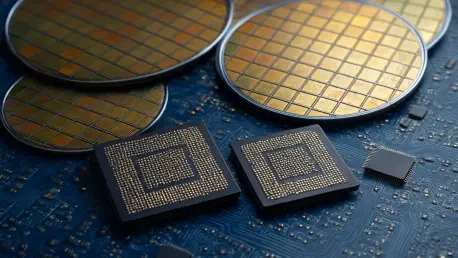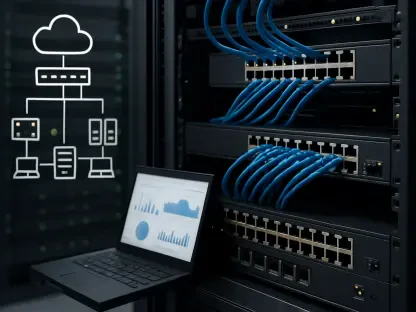In a world increasingly defined by connectivity and automation, semiconductors stand as the invisible yet indispensable force propelling technological breakthroughs that reshape daily life, driving everything from smart household gadgets to lightning-fast communication networks and vehicles that navigate without human input. These tiny chips, often overlooked amidst the hype of artificial intelligence and other trending buzzwords, are the true enablers of a digital revolution. Their ability to process data, facilitate communication, and make split-second decisions underpins the promise of a seamlessly integrated future where technology anticipates and responds to needs in real time. This exploration delves into the pivotal role semiconductors play across three transformative domains: the Internet of Things (IoT), 5G connectivity, and autonomous technology. By unpacking their contributions, it becomes clear that semiconductors are not merely components but the very foundation upon which modern innovation is built. From enabling a thermostat to adjust a room’s temperature based on learned patterns to ensuring a car can dodge an unexpected obstacle, these chips are the silent architects of progress. The journey through their impact reveals a complex interplay of technical advancements, industry dynamics, and societal implications, highlighting why their evolution remains critical to the trajectory of global technology.
The Foundational Force Behind Digital Innovation
Semiconductors serve as the bedrock of today’s technological landscape, forming a vital link with emerging systems that define modern life. Their role extends beyond mere functionality; they act as catalysts for growth in IoT, 5G, and autonomous platforms by managing essential tasks like data processing, network connectivity, and real-time analytics. This relationship is dynamic, with the escalating demands of these technologies spurring continuous advancements in chip design and capabilities. Unlike earlier eras where chips were general-purpose, today’s semiconductors are increasingly specialized, crafted to meet the precise needs of each field they support. This adaptability ensures that whether it’s a small sensor in a smart device or a powerful processor in a data hub, the underlying technology is optimized for performance. Their significance lies not just in enabling current systems but in pushing the boundaries of what’s possible, creating a feedback loop where innovation in one area fuels progress in another. This cycle of improvement underscores why semiconductors are often dubbed the backbone of the digital age, silently powering the tools and systems that have become integral to society.
The impact of semiconductors also shines through in their ability to evolve alongside technological challenges. As devices become smaller and more complex, chips must balance power efficiency with computational strength, often under tight constraints. This evolution is evident in how they’ve been engineered to handle diverse workloads, from minimal energy use in battery-powered gadgets to high-intensity tasks in network infrastructure. Their design now incorporates advanced materials and architectures that push past traditional limitations, ensuring they remain relevant amid rapid change. This relentless adaptation not only sustains current technologies but also lays the groundwork for future breakthroughs, making semiconductors a linchpin in the ongoing quest for smarter, more connected environments. Their quiet yet profound influence is felt across industries, proving that without these chips, the vision of a fully integrated digital world would remain out of reach.
Transforming Everyday Life Through IoT
The Internet of Things (IoT) has ushered in an era where everyday objects, from kitchen appliances to industrial machinery, communicate and operate with embedded intelligence, all made possible by semiconductors. These chips, often designed as System-on-Chips (SoCs), combine multiple functionalities into a single compact unit, enabling devices to process data and connect to networks while conserving energy. Their ultra-low-power configurations are crucial for IoT applications, allowing small, battery-operated devices to function for extended periods without frequent recharges. This efficiency is what permits a smartwatch to track health metrics for days or a sensor in a remote factory to monitor equipment health without constant maintenance. The seamless integration of semiconductors into these devices transforms how environments are managed, creating networks of interconnected tools that enhance convenience and productivity in homes, workplaces, and beyond. Their role is pivotal in turning ordinary objects into smart solutions that anticipate user needs and optimize resource use.
Miniaturization stands as another cornerstone of semiconductor contributions to IoT, with chips now reduced to processes as minute as 3 nanometers. This shrinking scale allows intelligence to be embedded into even the smallest items, making it feasible to integrate sensors and processors into wearables, household items, or tiny tracking devices. Such advancements mean that a simple sticker on a package can relay real-time location data, or a medical implant can transmit vital signs to healthcare providers. The ability to pack powerful computing into minuscule forms has revolutionized the scope of IoT, enabling a proliferation of connected solutions that were once unimaginable. This trend not only democratizes access to smart technology but also drives innovation in how data is collected and utilized, fostering environments where every interaction is informed by real-time insights. Semiconductors, in this context, are the silent enablers of a world where connectivity is woven into the fabric of daily existence.
Building the Backbone of 5G Connectivity
5G networks represent a leap forward in communication technology, promising unprecedented speeds and near-instantaneous response times, and semiconductors are the critical components making this vision a reality. These chips are engineered to manage high-frequency signals and maintain low latency, essential for supporting the massive data demands of modern applications. Advanced materials like gallium nitride (GaN) and silicon carbide (SiC) are increasingly used in their construction, offering superior efficiency and heat dissipation compared to traditional silicon. This is particularly vital for 5G base stations and devices that must operate under intense conditions to deliver consistent performance. Whether it’s streaming high-definition content without buffering or enabling real-time industrial automation, semiconductors ensure that 5G networks can handle the load, setting a new standard for connectivity that transforms how data is shared and accessed across the globe.
Beyond raw performance, semiconductors in 5G systems are also integrating artificial intelligence to enhance network management. AI-enabled chips optimize traffic flow, reduce congestion, and prioritize critical data packets, ensuring reliability for applications where timing is everything, such as remote medical procedures or immersive gaming experiences. This intelligent approach to connectivity means that networks can adapt dynamically to user demands, maintaining efficiency even during peak usage. The role of semiconductors here is not just about speed but about creating smarter, more responsive systems that underpin a connected society. As 5G continues to roll out and expand, the innovations in chip technology will remain central to overcoming challenges like signal interference and energy consumption, ensuring that the promise of instantaneous communication is not just met but exceeded in diverse and demanding scenarios.
Propelling Autonomous Systems to New Heights
Autonomous technology, particularly in vehicles often described as “servers on wheels,” relies heavily on semiconductors to achieve the computational prowess needed for self-navigation. These systems process enormous volumes of data from an array of sensors including cameras, LiDAR, and radar, requiring chips that can deliver high-speed calculations in real time. Specialized hardware such as Neural Processing Units (NPUs) and Graphics Processing Units (GPUs) are integral, handling complex AI algorithms and sensor fusion to create a comprehensive understanding of a vehicle’s surroundings. This capability allows a car to detect pedestrians, interpret traffic signals, and react to sudden obstacles within milliseconds. The sheer scale of data processing involved highlights the indispensable nature of semiconductors in turning autonomous driving from a concept into a practical, everyday reality that could redefine transportation.
Safety remains a paramount concern in autonomous systems, and semiconductors are designed to meet rigorous standards to ensure reliability in critical situations. Chips for these applications adhere to strict Automotive Safety Integrity Level (ASIL) guidelines, guaranteeing that they can make life-or-death decisions without failure. This focus on dependability means that whether a vehicle is navigating a busy urban intersection or a quiet rural road, the underlying technology can be trusted to prioritize safety above all else. The advancements in semiconductor design also address power efficiency and thermal management, ensuring that these high-performance systems operate without overheating or draining energy reserves. As autonomous technology advances toward higher levels of independence, the role of semiconductors in maintaining safety and performance will only grow, shaping a future where human error on the roads could become a relic of the past.
Navigating Industry Trends and Corporate Strategies
The semiconductor industry is experiencing a remarkable surge, with projections estimating the global market to exceed $1 trillion by 2030, fueled by the escalating demands of IoT, 5G, and autonomous technologies. Leading companies such as NVIDIA, Qualcomm, and TSMC are at the forefront, channeling significant investments into developing specialized chips and cutting-edge manufacturing processes. Their efforts span a wide range of applications, from AI accelerators that power machine learning to automotive platforms that enable connected vehicles. This strategic focus not only drives technological progress but also positions these firms as dominant players in a highly competitive landscape. Their ability to innovate at scale ensures that the foundational technologies needed for emerging fields are readily available, supporting a wave of transformation across multiple sectors with far-reaching implications.
Simultaneously, a notable shift is occurring as major tech giants like Google, Amazon, and Apple move toward designing custom silicon to gain greater control over the integration of hardware and software. This trend of vertical integration disrupts conventional supply chains, fostering a new dynamic where traditional component providers face increased competition while foundries and specialized manufacturers find fresh opportunities. The push for in-house chip development reflects a broader industry realization that tailored solutions can offer significant advantages in performance and efficiency. As partnerships and rivalries intensify, the semiconductor sector is becoming a battleground for innovation, with implications for how quickly and effectively new technologies can be brought to market. This evolving corporate landscape underscores the strategic importance of semiconductors as not just tools but as critical assets in shaping the future of tech.
Balancing Societal Benefits with Emerging Risks
Semiconductor-driven advancements hold immense promise for improving quality of life through smarter urban environments, safer transportation, and enhanced healthcare solutions. IoT and 5G technologies enable real-time data analytics that optimize everything from traffic flow in cities to energy usage in industrial settings, creating efficiencies that benefit both economies and individuals. Autonomous vehicles, powered by sophisticated chips, have the potential to drastically reduce accidents caused by human error, offering a vision of roads where safety is paramount. The economic ripple effects are substantial, with industries poised for growth as these technologies create new markets and job categories. The transformative potential of semiconductors in these areas paints a picture of a future where technology seamlessly enhances daily experiences, addressing long-standing challenges with innovative, data-driven approaches.
However, the rapid proliferation of these technologies also introduces significant challenges that cannot be ignored. Supply chain vulnerabilities, exposed by recent shortages, reveal the risks of geographic concentration and geopolitical tensions impacting chip availability. The vast network of connected devices enabled by IoT and 5G expands the surface for cybersecurity threats, where a single breach could compromise personal privacy or critical infrastructure. Ethical dilemmas surrounding AI in autonomous systems further complicate the landscape, raising questions about accountability in scenarios where decisions have life-altering consequences. These issues highlight the need for robust frameworks to address risks while harnessing benefits. As society navigates this dual reality, the role of semiconductors as both enablers of progress and sources of complex challenges becomes ever more apparent, demanding careful consideration and proactive solutions.
Charting the Path Forward for Semiconductor Innovation
Reflecting on the journey of semiconductor development, it’s evident that these components have been central to some of the most groundbreaking shifts in technology over recent decades. Their evolution enabled the rise of interconnected IoT ecosystems, supported the rollout of 5G networks that redefined communication, and powered the complex systems behind autonomous vehicles that promised safer travel. Each milestone achieved in chip design, from miniaturization to the adoption of advanced materials, played a crucial role in overcoming barriers that once seemed insurmountable. The relentless drive to meet the demands of emerging fields shaped a landscape where digital intelligence became ubiquitous, transforming how industries operated and how individuals interacted with their surroundings. Looking back, the impact of semiconductors stands as a testament to human ingenuity in harnessing technology to solve intricate problems.
Moving into the future, the focus must shift toward addressing persistent challenges while capitalizing on upcoming opportunities in semiconductor innovation. Prioritizing resilient supply chains through diversified manufacturing and strategic stockpiling can mitigate risks of shortages. Enhancing cybersecurity measures for connected devices will be essential to protect against evolving threats, ensuring trust in digital systems. Additionally, fostering global collaboration to tackle ethical concerns in AI-driven technologies can pave the way for responsible deployment. Investing in education and training to build a skilled workforce will support sustained progress, while continued research into next-generation materials and computing paradigms like quantum technology holds the potential to unlock unprecedented capabilities. As the industry advances, these steps will ensure that semiconductors continue to drive meaningful change, shaping a world where technology serves humanity with both power and purpose.









